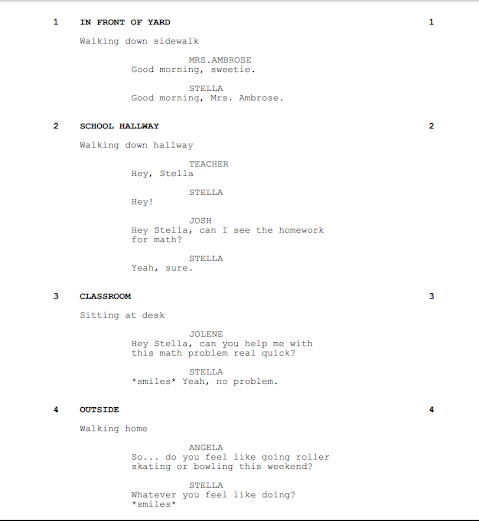Basics of A Script
When writing a script, there are several components that come into play to make the script what it is. Each of those components have significant meanings and play key parts when creating a script.
Scene Heading
The scene heading sometimes called Slugline, tells the reader of the script where the scene takes place. It tells us if we’re indoors (INT) or outdoors (EXT). You are meant to name the location and time of day. All this information is to set the scene for your reader.
Action
The action or description sets the scene, describes the setting, and allows you to introduce your characters and set the stage for the story. You should always write in present time for action. Also avoid the need to write camera angles and shots. If you must emphasize some shot, write it on a single line.
Character Name
Before a character speaks, you are to insert the character’s name to let the readers know the character’s dialogue follows. The name can be an actual name, occupation, or a description of the character that is to speak.
Dialogue
The rules of dialogue apply to anyone who speaks on screen, during a conversation between characters, talks out loud to themselves, or even when a character is off screen but is still heard. If the dialogue is good it could be the window to the soul of your character.
Parenthetical
A parenthetical mark can be attitude, verbal direction, or action direction for the actor who is speaking the part. They should be short, to the point, descriptive, and should only be used when absolutely necessary.
Extension
A technical note placed directly to the right of the character name the denotes how the character’s voice will be heard by the audience. Some writers use O.C. (off camera) in place of O.S. Another common extension is V.O. which stands for voice over. This is meant to be a narration or a character speaking while they are not on screen.
Transition
Nowadays, people believe transitions are a waste of space and recommend to use them only when absolutely necessary. But if you were to use them, it’s better to use them to better visualize the story.
Shots
A shot tells the reader the focal point within a scene has changed. You want the audience to see something not obvious in the scene or you want to achieve a particular emotion or to build to a climax. This component helps you to do just that.
Using all of these components my group was able to compose the script for our opening scene.


Comments
Post a Comment